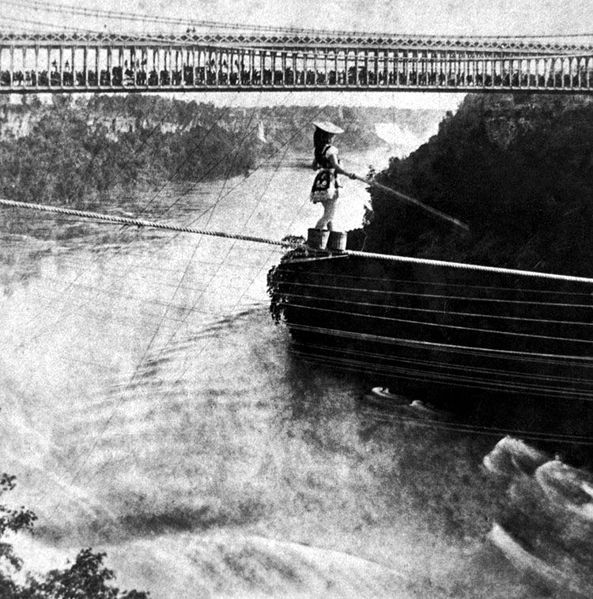Maria Spelterini is pictured above. Read more stories of funambulists in history at Atlas Obscura.In the 1800s everyone wanted to walk across Niagara Falls. The first to do so was Jean François Gravelet, known as the Great Blondin, who was the most famous wire-walker of the time. He crossed the Falls in 1859, pausing in the middle to sit down and drink a beer he pulled up on a rope from the Maid of the Mist. He would return to the Falls again and again, doing crazier highwire stunts each time: riding a bicycle across, cooking an omelet in the middle, going across blindfolded or on stilts, and even carrying his manager across on his back. Next up was the Great Farini (né William Leonard Hunt), one of the most celebrated acrobats in Europe at the time. He duplicated many of the Great Blondin's stunts, and his coup de grâce in 1860 was crossing the Falls with a washing machine strapped to his back; in the middle he stopped to wash several handkerchiefs, which he then gave to his waiting admirers. Maria Spelterini, a circus performer from the age of 3, was the first woman to wire-walk across the Falls, and she also did it many times — once with her wrists and ankles manacled, once with a paper bag over her head, and once with peach baskets on her feet.
Welcome to ...
The place where the world comes together in honesty and mirth.
Windmills Tilted, Scared Cows Butchered, Lies Skewered on the Lance of Reality ... or something to that effect.
Windmills Tilted, Scared Cows Butchered, Lies Skewered on the Lance of Reality ... or something to that effect.
Monday, November 10, 2014
An Abridged History of Funambulists
Funambulism
is a Greek word meaning tightrope walker. Rope walkers in ancient
Greece and Rome couldn’t get into the Olympics, but their skills instead
entered the show business arena. Over the centuries, competition among
these acrobats led to the development of other acts, such as the flying
trapeze and other aerial stunts, and also led to ever greater stunts,
like walking a wire above Niagara Falls.
Subscribe to:
Post Comments (Atom)


No comments:
Post a Comment